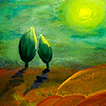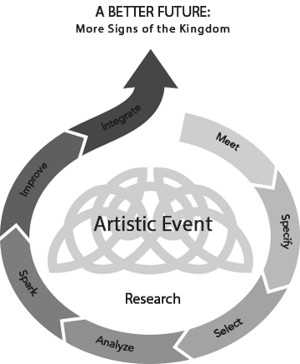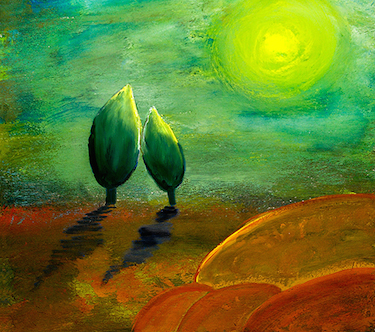Creating Local Arts Together
Seven Steps for Facilitating Arts in Community

CASE ONE: In northwestern DR Congo, Mono Christians are making a fundamental change in how they communicate with God. Instead of using only international and regional artistic genres in their gatherings, they have integrated local arts. This movement is spreading from the hub of Bili to many other villages, and they are seeing a “radical change in how Christians live, because God’s message communicated through kundi (traditional harp) songs directly touches their hearts.” 1
CASE TWO: In Central Asia, a large ethnolinguistic community is experiencing intergenerational healing: Instead of letting national education replace traditional learning, they are integrating local arts into the educational system. Because of this, older people are experiencing renewed respect and value, and children are learning the best parts of their traditional culture while succeeding in government schools. One official remarked, “I see the students growing in their confidence in learning, but also they are growing in their ability to learn.”
CASE THREE: In Richmond, Virginia (US), multiethnic churches have begun to worship, well…multiethnically: At least one worship leader is composing theology-rich songs for his African-American context, and teaching others to become students of their congregations, especially in learning about the arts of minorities among them. David Bailey writes, “We have a 70 percent rule—if you find yourself comfortable more than 70 percent of the time, then something is wrong, because that means your culture is dominating the community!”2
In each of these cases, a community has to overcome barriers like these to succeed:
- Rifts in communication between older and younger generations
- Unfounded negative self-identities
- Lack of skills and perspective necessary to meet changing demands of globalized economies and media and
- Theological misunderstandings
Also in each case, a person with special perspective and skills helped the community overcome obstacles with activities like these:
- They gathered church leaders and facilitated Bible studies on creation, worship, music, arts, and the kingdom of God
- They provided a framework for younger and older community members to meet, listen to each other, learn from each other, and together plan ways to integrate older traditions into modern realities
- They commissioned artists to integrate Scripture into new examples of old arts
- They helped create a Community Arts Survey 3
A new manual reduces thousands of insights from situations like these into a user-friendly, flexible, research-based approach that you can use in a community you know: Creating Local Arts Together: A Manual to Help Communities Reach Their Kingdom Goals (William Carey Library 2013). 4
WHAT'S IN THE MANUAL
This manual emerged from a relatively new community of practice: ethnodoxology.
Ethnodoxologists and friends (not everybody uses this word) invest themselves in incarnational relationships with communities, helping them unleash their unique arts in deepening and spreading the kingdom of God. Our ultimate goal is to help others create, offering insights gained from our scholarship and experiences ministering
in rural and urban contexts all over the world.
In particular, the manual gently walks you through the Creating Local Arts Together approach, euphonically known as CLAT. See the figure below. The CLAT approach has seven key steps:
-
 MEET a Community and Its Arts. Explore artistic and social resources that exist in the community. Performing Step 1 allows you to build relationships, to participate with and understand the people, and to discover the hidden treasures of the community.
MEET a Community and Its Arts. Explore artistic and social resources that exist in the community. Performing Step 1 allows you to build relationships, to participate with and understand the people, and to discover the hidden treasures of the community. - SPECIFY Kingdom Goals. Discover the kingdom goals that the community wants to work toward. These could include deeper worship, greater shalom, healthier families, more disciples of Christ, and more. Performing Step 2 ensures that you are helping the community work toward aims that they have agreed on together.
- SELECT Effects, Content, Genre, and Events. Choose an artistic genre that can help the community meet its goals, and activities that can result in purposeful creativity in this genre. Performing Step 3 reveals the mechanisms that relate certain kinds of artistic activity to their effects, so that the activities performed have a high chance of succeeding.
- ANALYZE an Event Containing the Chosen Genre. Describe the event and its genre(s) as a whole, and its artistic forms as arts and in relationship to broader cultural context. Performing Step 4 results in detailed knowledge of the art forms that is crucial to sparking creativity, improving what is produced, and integrating it into the community.
- SPARK Creativity. Implement activities the community has chosen to spark creativity within the genre they have chosen. Performing Step 5 actually produces new artistic works for events.
- IMPROVE New Works. Evaluate results of the sparking activities and make them better. Performing Step 6 makes sure that the new artistry exhibits the aesthetic qualities, produces the impacts, and communicates the intended messages at a level of quality appropriate to its purposes.
- INTEGRATE AND CELEBRATE for Continuity. Plan and implement ways that this new kind of creativity can continue into the future. Identify more contexts where the new and old arts can be displayed and performed. Performing Step 7 makes it more likely that a community will keep making its arts in ways that produce good effects long into the future.
 ONE SHORT WEEK TO LEARN THE APPROACH: ARTS FOR A BETTER FUTURE
ONE SHORT WEEK TO LEARN THE APPROACH: ARTS FOR A BETTER FUTURE
You can pick up this manual, start reading and applying it, and probably see small changes in and around you very soon. Better yet, you can immerse yourself in the arts-in-the-kingdom world for one week, walking out with two things: a deep understanding of the CLAT approach and a plan to apply it to a community you know. This happens in Arts for a Better Future (ABF) seminars. 5
ABF instructors lead participants through three CLAT cycles. In the third and final cycle, participants break into small groups, choose a community they know well, and use the manual to draft a plan to encourage kingdom-deepening creativity in that community. The results are amazing.
YOU SHOULD DO IT
God gave every community unique gifts of artistic communication to tell the Truth, and bring healing and hope and joy in response to the groanings of creation. Many of these gifts, however, lie dormant, misused, or dying. You can help people reclaim their arts, enter the kingdom, and thrive.









comments